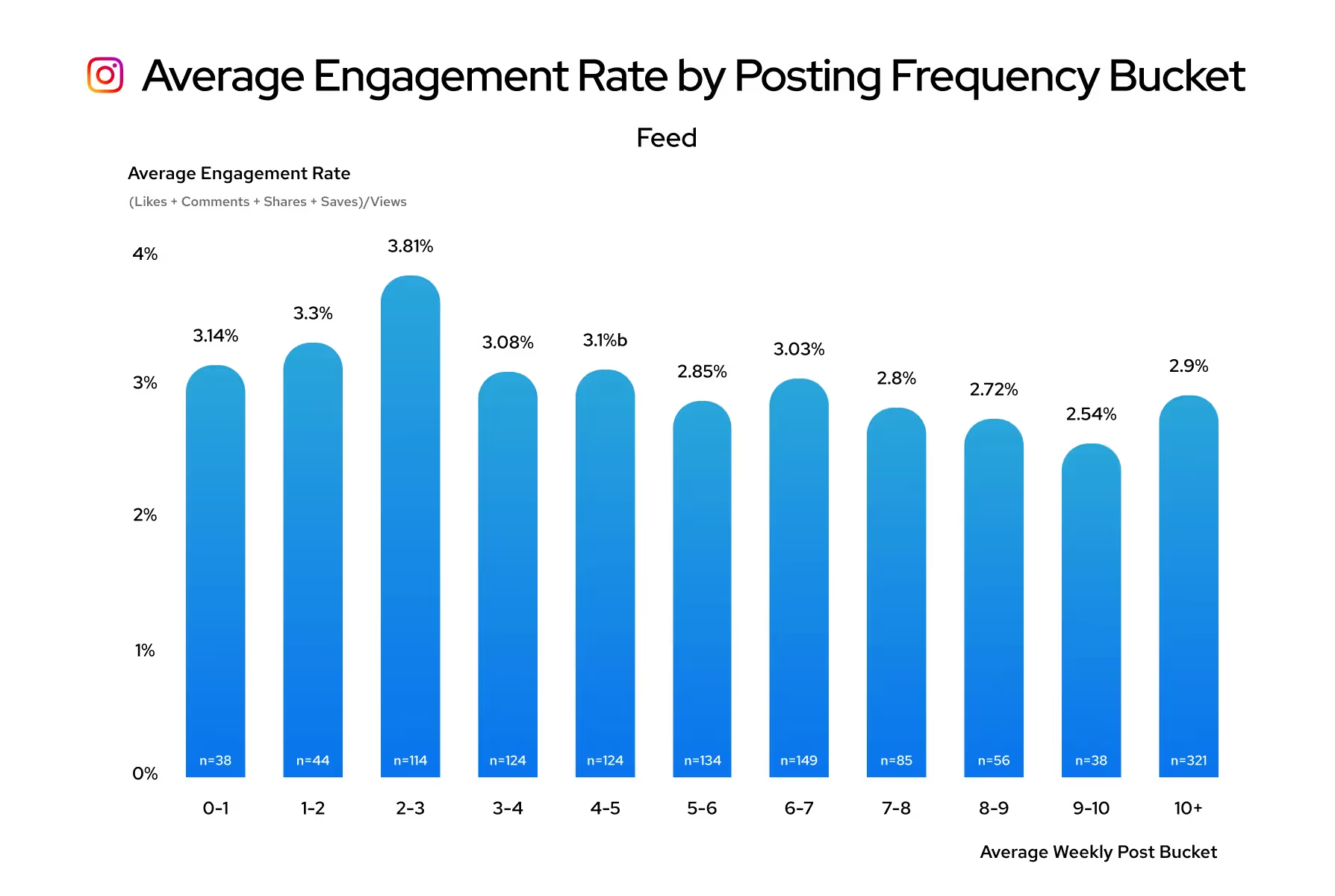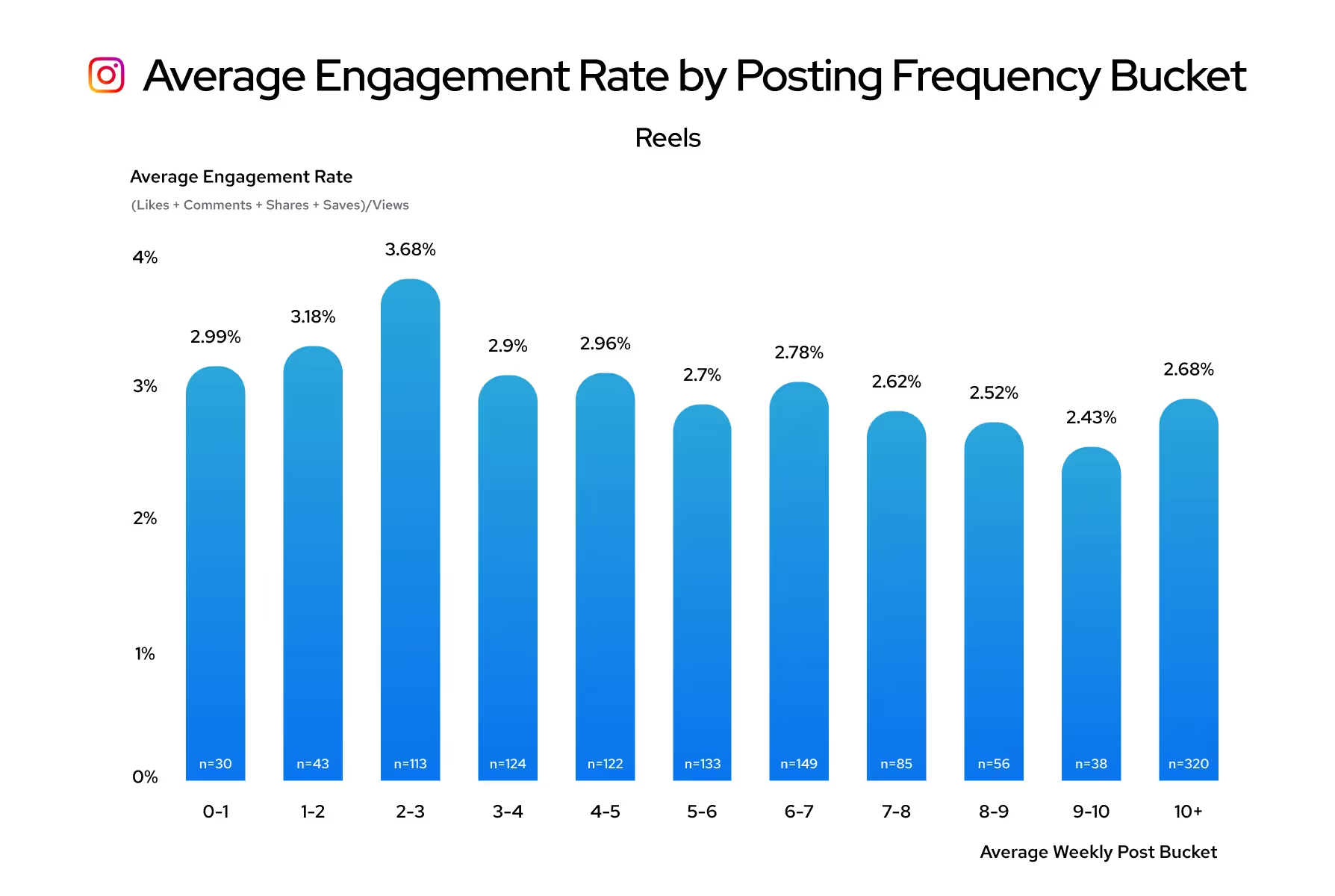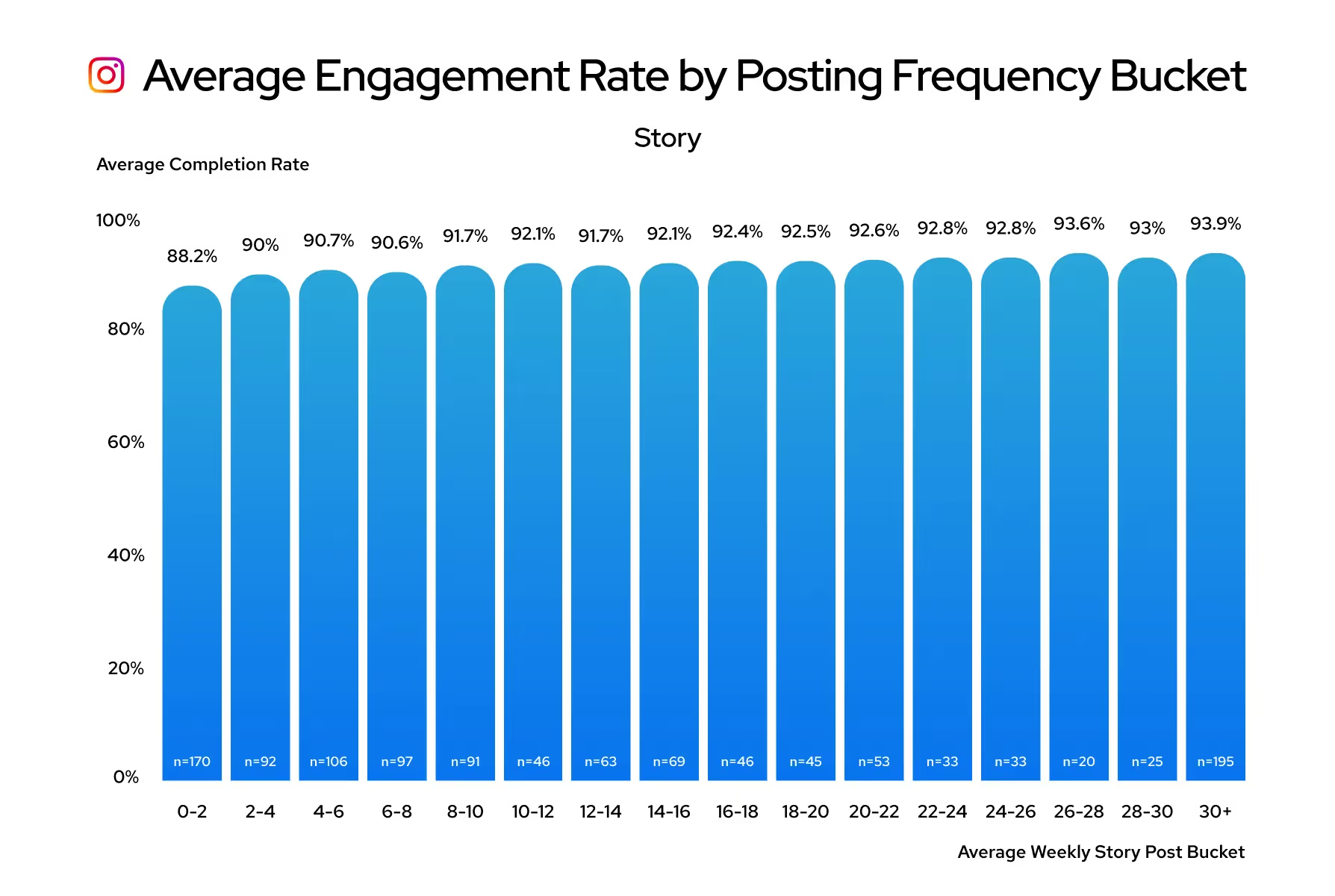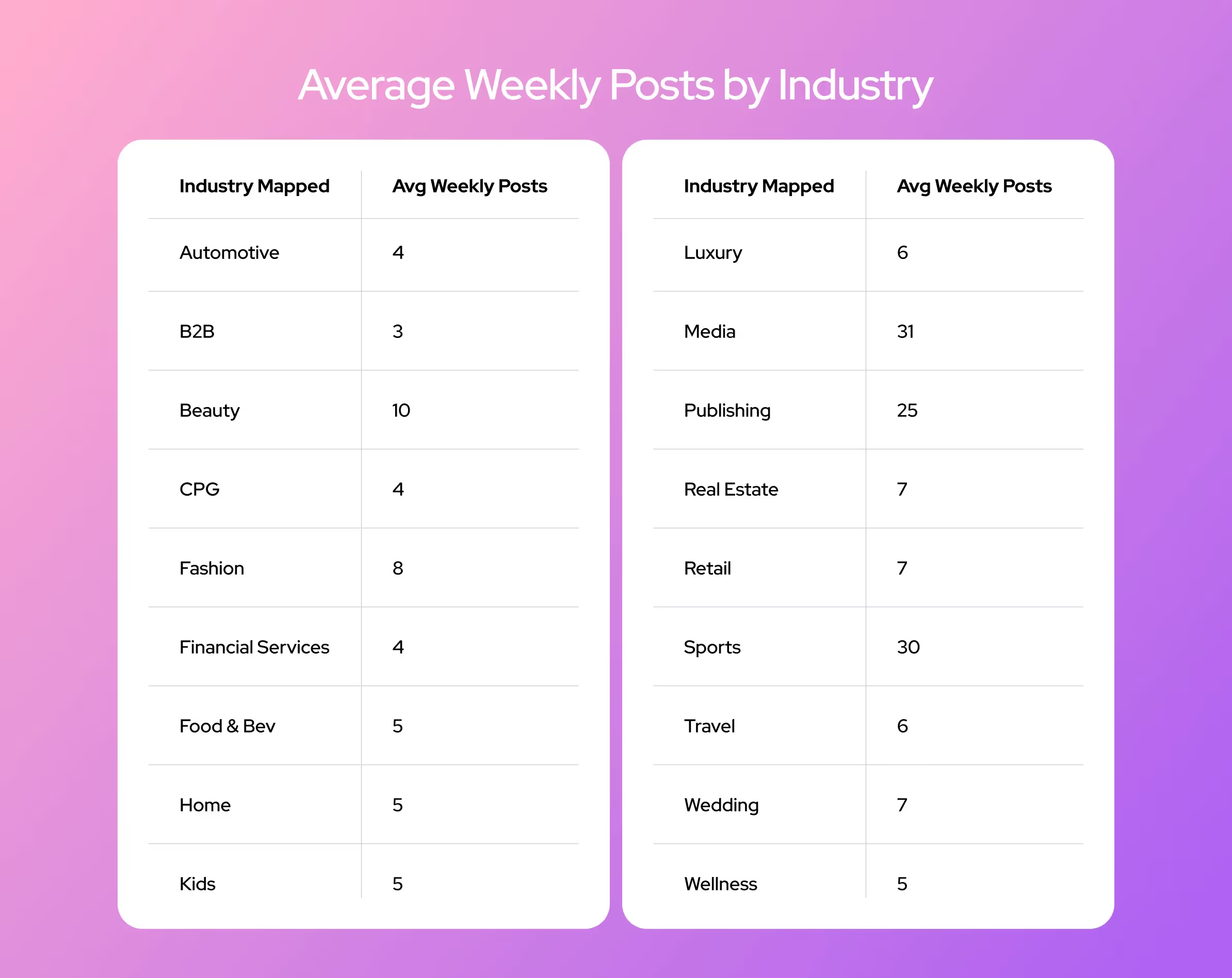How Often Should You Post on Instagram in 2025?
Posting too much or too little? Here’s what the data actually says.
.avif)
Contents
Why Posting Frequency Matters on InstagramHow Often To Post on Instagram Weekly for the Best ResultsHow Often Should You Post Reels on InstagramHow Often Should You Post Stories on InstagramHow Often Should a Business Post on Social Media (By Industry)Guidelines for Instagram Posting in 20255 Tips for Finding How Often To Post on InstagramNow, Discover The Best Time To Post How Often Should You Post on Instagram FAQsIf you’ve ever wondered whether you're posting too much or not enough on Instagram, you’re not alone. Between Reels, carousels, Stories and Lives, figuring out the ideal posting frequency on Instagram can feel like trying to hit a moving target. And while no magic number works for everyone, there has to be a smarter way to approach it, right?
Finding this smarter approach is why we’re diving into the data to answer one of the biggest questions for brands and creators in 2025: How often should you post on Instagram? To get there, we analyzed over 2.1 million total Instagram posts (feed posts + Story posts). We grouped accounts based on how frequently they posted each week, then compared average engagement rates across content types to reveal what’s actually working. Let’s break it down.
Methodology: The data featured in this article was collected and analyzed by Dash Social’s Senior Data Analyst. Our insights are based on performance data from over 1.2 million Instagram feed posts (single image, carousel formats and Reels) and 941,000 Stories published globally by approximately 3,000 unique brands using the Dash Social platform. For Reels-specific analysis, we isolated over 529,000 Reels from the broader dataset. All data spans a 10-month period, from July 2, 2024, to May 14, 2025, using average engagement rate as the primary success metric for feed posts and Reels. For Stories, performance was measured using average completion rate.
TL;DR:
- Posting 2 to 3 times per week on Instagram feeds and Reels drives the highest engagement without risking burnout
- Stories work best at 30+ posts per week or about 4 per day to keep followers engaged and boost completion rates
- The ideal posting frequency varies by industry with sports and media posting most often and B2B brands posting least
- A sustainable, intentional posting strategy that blends formats like Reels, carousels and Stories keeps content fresh and effective
- Tracking performance by format and audience behavior is key to refining your posting cadence and maximizing results
Why Posting Frequency Matters on Instagram
Before diving into the numbers, let’s talk about why posting frequency matters. It’s easy to believe that quality alone will carry your content, but the reality is that how often you post on Instagram plays a major role in your visibility, engagement and long-term brand growth.
Consistently posting Reels, Stories and feed content signals to Instagram’s algorithm that your account is active and worth surfacing. That activity boosts your chances of appearing in the Explore tab, being shared by other accounts or appearing higher in Instagram’s search feature. As a bonus, the more you post, the more performance data you gather, giving you valuable insight into what resonates so that you can test, learn and refine your strategy over time.
“Consistent, thoughtful posting keeps you top-of-mind, fosters community and gives new followers a reason to stick around,” says Nikki Del Mundo, Dash’s Senior Digital Content Manager and driving force behind our own brand’s social presence.
“But frequency alone isn’t enough,” she adds. “Posting too often can lead to burnout, resulting in low-value content and disengagement. The goal is a well-paced, sustainable strategy that builds connection and keeps your community coming back for more.”
In short, it’s not just about It’s posting more often, it’s about posting with intention. Frequency matters because it tells the algorithm you’re invested and shows your audience you’re worth following.
How Often To Post on Instagram Weekly for the Best Results
TL;DR: Post 2 to 3 times per week on Instagram.
In a recent video, Instagram’s CEO, Adam Mosseri, tackled one of the platform's most frequently asked questions: How often should you post on Instagram? His response was simple but clear: the more you post, the more people you’re likely to reach. And over time, that increased reach can naturally lead to follower growth. But Mosseri also offered an important caveat: posting more shouldn’t come at the cost of your creativity or your well-being. When creators push too hard and reach burnout, content quality suffers. If you stop enjoying the process, your audience can tell. And if that connection is lost, everyone loses.
So yes, we know from the source that posting often matters. But what does ‘often’ actually mean? How often should you be posting on Instagram?
To find a data-backed answer, we analyzed close to 1.2 million Instagram feed posts — made up of single image, carousel formats and Reels — posted from ~3,000 brands over the last ten months. (We excluded Stories from this analysis since they serve a different purpose and are measured with different success metrics. More on that later).
The results? Brands that posted 2 to 3 times per week to their feed saw significantly higher engagement rates than those posting more or less frequently. This sweet spot is consistent with what we see from other industry experts, including Hootsuite, which suggests posting at least three times per week to maintain visibility and engagement.

Keep in mind, these are averages, not requirements. Some accounts far surpass 2-3 posts per week, while others post less. Most brands in our dataset fall into the category of 10+ posts, signalling that a more frequent posting schedule is what works best for them. The answer to what will work for your brand lies in testing, measuring and identifying the rhythm that aligns with your goals and your audience’s preferences. To find the ideal posting schedule, you’ll need to dig into your data. Using a social media analytics tool can help you track performance trends across your Reels, feed posts and Stories to pinpoint what’s working for you.
How Often Should You Post Reels on Instagram
TL;DR: Post Reels 2 to 3 times per week on Instagram.
For brands, Reels shouldn’t be treated as a standalone tactic; they’re most effective when integrated into your broader Instagram marketing content strategy. That said, for research purposes, we broke out the data to answer the specific question of how many Reels should you post a week.
According to our analysis, much like the overall data suggests, brands that post 2 to 3 Reels per week tend to see the highest engagement rates on video content.

Since this aligns with the overall feed strategy (which also includes Reels), we recommend mixing up the types of content you share week to week. For example:
- Week 1: 2 Reels + 1 carousel
- Week 2: 3 Reels
- Week 3: 1 static post + 1 carousel + 1 Reel
Test different combinations and see what your audience enjoys the most. A consistent, creative approach to Reels, when thoughtfully incorporated into your overall strategy, can drive lasting results.
How Often Should You Post Stories on Instagram
TL;DR: Post Stories 30+ times per week on Instagram.
Unlike Reels or feed posts, Instagram Stories are designed to create a connection with your existing followers, not attract new ones. That makes them less about expanding reach and more about deepening engagement with the audience you’ve already built. Think of Stories as a tool for nurturing your community: keeping your brand present, personal and relevant in the daily scroll. But with a lifespan of just 24 hours, do Stories behave differently than other content formats on Instagram? And does that short shelf life affect how often you should post them?
According to our data, the answer is yes. Brands that post 30+ stories a week (that’s about 4 or 5 a day) tend to see the highest average completion rates. The percentages across the board are close, but our analysis shows that 26 or more Stories per week is the general range where engagement starts to peak. So, if you're looking for the ideal range, aim for around 4 Stories a day.

Back in 2021, Instagram Head Adam Mosseri recommended posting at least 2 Stories a day. While that guidance was helpful at the time, audience behavior has shifted, so it’s no surprise that the benchmark has evolved.
If posting 30+ Stories a week sounds overwhelming, don’t worry. Each frame in a Story sequence counts as a separate Story. Many brands use this format to tell short, compelling narratives across a series of images or videos, which can then be saved long-term within the ‘Highlights’ portion of your Instagram profile. A connected story keeps your audience engaged and invested in what you’re sharing. And remember: quality still matters more than quantity. Stories are meant to be in-the-moment and can be more informal, so they often require less prep, but each one should still have a purpose. Keep them intentional, but don’t be afraid to keep them real.
How Often Should a Business Post on Social Media (By Industry)
At Dash Social, we’re all about data, especially when it comes to industry-specific social media benchmarks. So just for fun (and insight), we broke down our dataset by industry to see how often brands across different sectors are posting on Instagram. The results offer a snapshot of what ‘average’ looks like, depending on your niche. Here’s what we found:

Out of all the industries we analyzed, sports and media brands post the most on Instagram, averaging 30 to 31 posts per week, respectively. And it tracks, between a constant flow of fan-generated content, real-time updates from games or shows and content featuring athletes and celebrities, there’s no shortage of moments worth sharing.
As for who posts the least — no surprise here — it’s B2B brands, averaging just 2 to 3 posts per week. Unlike Sports or Media brands (and we say this with love), there aren’t exactly hordes of die-hard fans refreshing their feeds for the latest update from a B2B company.
That said, as a B2B industry brand ourselves, we know there are exciting things worth sharing. It just tends to happen at a different pace. To prove we take our own advice, we had our Senior Data Analyst pull our own posting stats. With 28.9K followers on Instagram, we average around three posts per week (including at least one Reel) and share 6 to 7 Stories per week, right on par with the industry average. This steady, strategic approach helped us grow our audience by ~ 5,000 followers over the past year. Major shoutout to Nikki, who makes it all happen behind the scenes.
Guidelines for Instagram Posting in 2025
The platform is always shifting, and so are audience expectations. To stay relevant, your posting strategy needs to be thoughtful, flexible and rooted in what drives real engagement. The most successful brands create a posting cadence that’s both sustainable and flexible, allowing room to experiment with different formats and trends. They monitor performance closely and make data-informed decisions, rather than overloading their feed with content for content’s sake.
Before you hit post, ask yourself:
- Do we have the resources to maintain this schedule without compromising content quality?
- Are we using a mix of content formats to keep our feed fresh and engaging?
- Do we understand our audience’s behavior, what they respond to and when they’re most active?
- Are we posting at the right times? Tip: Use your analytics, or check out our article on the best times to post on Instagram, to optimize your timing.
To build an Instagram strategy that lasts, consistency should support your creativity, not strain it. Ultimately, your posting rhythm should align with your brand’s goals, audience habits and your team’s capacity to deliver content that adds real value rather than trying to hit a number.
5 Tips for Finding How Often To Post on Instagram
By now, you’ve realized there’s no universal answer to how often you should post on Instagram, but there is a strategy. You’ll need to experiment, measure and adjust based on what works to find the perfect amount. Here’s how to hone in on a posting cadence that drives results without burning out you and your team:
1. Start With What You Can Sustain
Posting daily might sound ideal, but not if it leads to burnout or low-effort content. Start with a cadence that’s manageable, whether that’s two times a week or three, and scale up as your workflow allows. One helpful trick is to establish a few recurring content series. Think AMA Fridays or ‘Best of UGC’ Mondays — simple, repeatable themes you can rely on to keep your content calendar steady without reinventing the wheel every week.
2. Test Different Frequencies
Try posting more or less over a few weeks and watch how your engagement, reach and follower growth respond. Use those insights to adjust. What works for one brand won’t always work for another. Pay attention to the signals: if engagement starts to dip, it may be time to reassess your volume, timing or content quality. Let the data guide your next move.
3. Track Content Performance by Format
Some brands thrive on Reels, others with carousels or Stories. They all serve different purposes and perform differently. Use your analytics to learn which formats your audience responds to most, and adjust your frequency per format accordingly.
4. Watch Your Audience Behavior
Pay attention to when your audience is most active and what types of content drive the most engagement. Look for patterns in how they interact with different formats, do they tap through Stories but save carousels? Do Reels spark more shares or comments? Posting at the right times and in the right formats can make a smaller content calendar work harder. Helping you do more with less.
5. Use Analytics to Refine Your Strategy
Leverage social media analytics tools to track performance trends over time. Look at metrics like engagement rate, reach, impressions per post and Story completion rates to get a clearer picture of how your audience responds to different content types and posting patterns. These insights are important for fine-tuning your cadence, doubling down on what resonates and making smarter, data-driven decisions that drive consistent results.

Custom analytics and reporting made simple.
Uncover at-a-glance stats, your top performing creative and more.
Discover Analytics and Custom ReportingNow, Discover The Best Time To Post
Now that you’ve got a clearer idea of how often to post on Instagram, the hardest part is behind you. The next step? Creating a schedule you can actually stick to. That’s where a social media content calendar and a reliable scheduler tool come in.
Tools like Dash Social’s Scheduler allow social media managers to save time and avoid burn out by scheduling posts in advance and leveraging personalized best time to post suggestions based on your own account data. In other words, staying consistent and strategic with your Instagram posts has never been easier.
How Often Should You Post on Instagram FAQs
Does posting on Instagram every day help?
Yes, posting on Instagram every day can help grow your account if you can maintain quality and consistency. Daily posts can boost visibility and engagement, but only if they’re adding value. If posting every day leads to rushed or low-quality content, it's better to stick to a sustainable schedule (like 2–3 times a week) that aligns with your goals and resources.
Should I post daily on Instagram starting out?
Not necessarily. When you’re starting out, focus on consistency and quality over quantity. If you can post daily without sacrificing content value, great, but even 1-2 well-crafted posts per week can help you build momentum. The key is staying consistent with what you can realistically maintain.
How often should I post on Instagram to gain followers?
To grow your follower base, aim to post at least 3 times per week. Brands and creators that post 2–3 high-quality pieces of content per week (including Reels, carousels or Stories) tend to see stronger engagement and steady follower growth. Consistency matters more than volume, so choose a pace you can sustain without sacrificing quality.



.avif)
